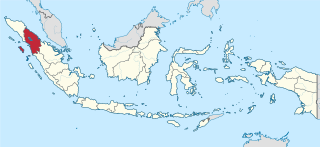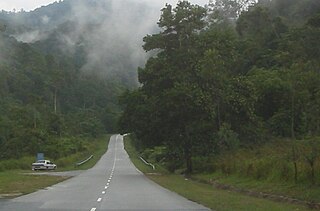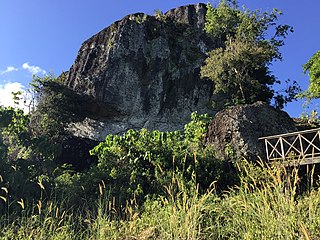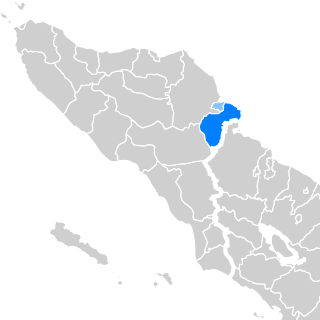
Sumatra is one of the Sunda Islands of western Indonesia. It is the largest island that is fully within Indonesian territory, as well as the sixth-largest island in the world at 482,286.55 km2 (182,812 mi.2), including adjacent islands such as the Simeulue, Nias, Mentawai, Enggano, Riau Islands, Bangka Belitung and Krakatoa archipelago.

Aceh, officially the Province of Aceh, is the westernmost province of Indonesia. It is located on the northern end of Sumatra island, with Banda Aceh being its capital and largest city. It is bordered by the Indian Ocean to the west, Strait of Malacca to the northeast, as well bordering the province of North Sumatra to the east, its sole land border, and shares maritime borders with Malaysia and Thailand to the east, and Andaman and Nicobar Islands of India to the north. Granted a special autonomous status, Aceh is a religiously conservative territory and the only Indonesian province practicing Sharia law officially. There are ten indigenous ethnic groups in this region, the largest being the Acehnese people, accounting for approximately 70% of the region's population of about 5.5 million people in mid-2023. Its area is comparable to Croatia or Togo.

Medan is the capital and largest city of the Indonesian province of North Sumatra. The nearby Strait of Malacca, Port of Belawan, and Kualanamu International Airport make Medan a regional hub and multicultural metropolis, acting as a financial centre for Sumatra and a gateway to the western part of Indonesia. About 60% of the economy in North Sumatra is backed by trading, agriculture, and processing industries, including exports from its 4 million acres of palm oil plantations. The National Development Planning Agency listed Medan as one of the four main central cities in Indonesia, alongside Jakarta, Surabaya, and Makassar. In terms of population, it is the most populous city in Indonesia outside of the island of Java. Its population as of 2023 is approximately equal to the country of Moldova.

North Sumatra, also called North Sumatra Province, is a province of Indonesia located in the northern part of the island of Sumatra, just south of Aceh. Its capital and largest city is Medan on the east coast of the island. It is bordered by Aceh on the northwest and Riau and West Sumatra on the southeast, by coastlines located on the Indian Ocean to the west, and by the Strait of Malacca to the east.

Aceh Jaya Regency is a regency of Aceh Province of Indonesia. It is located on the west side of the island of Sumatra, and was formed on 10 April 2002 from districts which had formerly been the northern part of West Aceh Regency. The regency covers an area of 3,872.23 square kilometres and had a population of 76,782 people at the 2010 census, 86,368 at the 2015 census and 93,159 at the 2020 Census, of whom 47,264 were male and 45,895 female; the official estimate as at mid 2023 was 99,717. The seat of the Regency is at Calang, in Krueng Sabee District. The main crops grown in the Regency are rice, rambutan, durian, orange, water melon, rubber, palm and coconut oil.

Binjai, formally Kota Binjai, is an independent city in the North Sumatra province of Indonesia, bordered by Deli Serdang Regency to the east and Langkat Regency to the west. Binjai is connected to Medan, about 22 km to the east, by the Sumatra highway that goes to Banda Aceh, and effectively forms a part of Greater Medan. The city's population was 181,904 in the 1990 Census, 224,516 in the 2000 Census, 246,154 in the 2010 Census, and 291,842 in the 2020 Census; the official estimate as of mid-2023 was 303,272, comprising 151,627 males and 151,645 females. In mid-2023, a further 49,217 inhabitants lived in Binjai District of Langkat Regency, outside the city limits but immediately north of the city.

Gunung Leuser National Park is a national park covering 7,927 km2 in northern Sumatra, Indonesia, straddling the border of Aceh and North Sumatra provinces, a fourth portion and three-fourths portion, respectively. The national park, settled in the Barisan mountain range, is named after Mount Leuser (3,119 m), and protects a wide range of ecosystems. An orangutan sanctuary at Bukit Lawang is located within the park. Together with Bukit Barisan Selatan and Kerinci Seblat National Parks, it forms a World Heritage Site, the Tropical Rainforest Heritage of Sumatra.

Lenggong or Lenggong Valley is a geographical area defined by the mountain ranges of Bintang in the west and Titiwangsa to its east. It is a rural area, with small kampongs surrounded by green vegetation and limestone hills with numerous caves.

Langsa, is a city in Aceh, Indonesia. It is located on the island of Sumatra. Apart from a small seacoast to the northeast, it borders Manyak Payed District of Aceh Tamiang Regency to the east and is otherwise surrounded by Birem Bayeun District of Aceh Timur Regency to the north, west and south. The city covers an area of 239.83 square kilometres and had a population of 148,945 at the 2010 Census ; this grew to 185,971 at the 2020 Census, and the official estimate as at mid 2023 was 194,730, comprising 97,579 males and 97,151 females.
Bukit, the Indonesian or Malay word for hill, may refer to:

The Sultanate of Deli was a 1,820 km2 Malay state in east Sumatra founded in 1632 when a commander of the Aceh Sultanate, Gocah Pahlawan, conquered the area during the reign of Iskandar Muda. A tributary kingdom from 1630 it was controlled by various sultanates until 1814, when it became independent and broke away from the Sultanate of Siak.

The Acehnese, also written as Atjehnese and Achinese, are an indigenous ethnic group native to Aceh, Indonesia on the northernmost tip of the island of Sumatra. The area has a history of political struggle against the Dutch colonial rule. The vast majority of Acehnese people are Muslims. The Acehnese people are also referred to by other names such as Lam Muri, Lambri, Akhir, Achin, Asji, A-tse and Atse. Their language, Acehnese, belongs to the Aceh–Chamic group of Malayo-Polynesian of the Austronesian language family.

The Gayo people are an ethnic group living in the highlands of Aceh Province, Sumatra, Indonesia. The Gayo tribe has a population of 336,856 and they live predominantly in the mountains. Most Gayo live in three regencies in Aceh namely Bener Meriah, Central Aceh, and Gayo Lues. Some of them live in several districts in other regencies, such as Serbejadi District, Simpang Jernih District, and Peunaron District in East Aceh Regency and Beutong District in Nagan Raya Regency. Other than that, the Gayo population also covers Southeast Aceh Regency and Aceh Tamiang Regency. Their homeland lies in the Barisan Mountains which has elevations of over 12,000 feet and extends more than one thousand miles. The Gayonese language has four dialects: Lut, Serbejadi-Lukup, Lut and Luwes. Their language does not have a writing system, but folk tales, stories and poetry are passed down in oral tradition. The traditional house of the Gayo is called Umah.

Prehistoric Indonesia is a prehistoric period in the Indonesian archipelago that spanned from the Pleistocene period to about the 4th century CE when the Kutai people produced the earliest known stone inscriptions in Indonesia. Unlike the clear distinction between prehistoric and historical periods in Europe and the Middle East, the division is muddled in Indonesia. This is mostly because Indonesia's geographical conditions as a vast archipelago caused some parts — especially the interiors of distant islands — to be virtually isolated from the rest of the world. West Java and coastal Eastern Borneo, for example, began their historical periods in the early 4th century, but megalithic culture still flourished and script was unknown in the rest of Indonesia, including in Nias and Toraja. The Papuans on the Indonesian part of New Guinea island lived virtually in the Stone Age until their first contacts with modern world in the early 20th century. Even today living megalithic traditions still can be found on the island of Sumba and Nias.

The Indonesian island of Sumatra is the sixth largest island in the world. The rich ethnic diversity and historical heritage in Sumatra is reflected in the range of architectural styles in the island. The vernacular style is the native Sumatran ethnic groups architecture of dwellings, while the Hindu-Buddhist architecture reflected through the cultural historical heritage of candis built in Sumatra. The third wave is Islamic architecture adopted in mosques and palace in Sumatra, especially in Aceh, North Sumatra, and Malay cultural sphere in the island.

Sultan Alauddin Ibrahim Mansur Syah, also known as Ali Alauddin Mansur Syah was the thirty-third sultan of Aceh in northern Sumatra. He was the eighth ruler of the Bugis Dynasty and ruled de facto from 1838, formally from 1857 to 1870.

Aru was a major Sumatran kingdom from the 13th to the 16th century. It was located on the eastern coast of North Sumatra, Indonesia. In its heyday the kingdom was a formidable maritime power, and was able to control the northern part of the Malacca strait.

Skull Hill is an archaeological hill site located at Tampi Tampi Road, about 10 kilometres (6.2 mi) south of Semporna town.

Tamiang Malay, is a Malayic language spoken in Indonesia, specifically in the Aceh Tamiang and significant minorities in Langsa on southeastern Aceh, bordering North Sumatra. It is primarily spoken by the native Malay people of Tamiang. Tamiang Malay is significantly different from Acehnese, the dominant language in Aceh, and they are mutually unintelligible. Instead, Tamiang Malay shows similarities to Langkat Malay and Deli Malay spoken in neighboring North Sumatra. Additionally, Tamiang Malay has been influenced by other languages, such as Acehnese and Gayonese, forming a distinct Malay dialect unique to the region. Tamiang Malay plays a significant role in the daily lives of the Tamiang community. For example, traditional ceremonies, community activities, and other social interactions are conducted in Tamiang Malay. Additionally, for the Tamiang people, Tamiang Malay is considered as a symbol of pride and a distinct regional identity. Most Tamiang people are proficient in Acehnese and Indonesian, in addition to their mother tongue.

Mount Abong-Abong or Mount Abongabong is a mountain located in Central Aceh Regency, Aceh Province, Indonesia, with an elevation of 2,985 m (9,793 ft). At the summit, there is a Dutch-era triangulation pillar marked with the serial number P.127. Mount Abong-Abong is located in the Bukit Barisan range, which stretches across several Regencies in Aceh, including Central Aceh Regency, Gayo Lues Regency and Nagan Raya Regency.



















